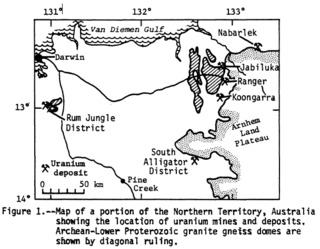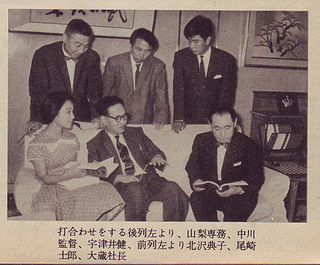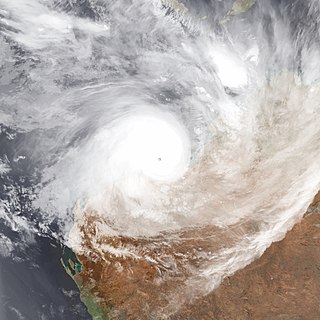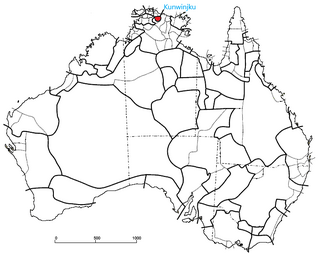In Australian Aboriginal mythology, Mamaragan or Namarrkon is a lightning Ancestral Being who speaks with thunder as his voice. He rides a storm-cloud and throws lightning bolts to humans and trees. He lives in a puddle.

The Top End of Australia's Northern Territory is a geographical region encompassing the northernmost section of the Northern Territory, which aside from the Cape York Peninsula is the northernmost part of the Australian continent. It covers a rather vaguely defined area of about 245,000 km² behind the northern coast from the Northern Territory capital of Darwin across to Arnhem Land with the Indian Ocean on the west, the Arafura Sea to the north, and the Gulf of Carpentaria to the east, and with the almost waterless semi-arid interior of Australia to the south, beyond the huge Kakadu National Park.

Diabase, also called dolerite or microgabbro, is a mafic, holocrystalline, subvolcanic rock equivalent to volcanic basalt or plutonic gabbro. Diabase dikes and sills are typically shallow intrusive bodies and often exhibit fine-grained to aphanitic chilled margins which may contain tachylite.

Alligator Rivers is the name of an area in an Arnhem Land region of the Northern Territory of Australia, containing three rivers, the East, West, and South Alligator Rivers. It is regarded as one of the richest biological regions in Australia, with part of the region in the Kakadu National Park. It is an Important Bird Area (IBA), lying to the east of the Adelaide and Mary River Floodplains IBA. It also contains mineral deposits, especially uranium, and the Ranger Uranium Mine is located there. The area is also rich in Australian Aboriginal art, with 1500 sites. The Kakadu National Park is one of the few World Heritage sites on the list because of both its natural and human heritage values. They were explored by Lieutenant Phillip Parker King in 1820, who named them in the mistaken belief that the crocodiles in the estuaries were alligators.

Gunbalanya is an Aboriginal Australian town in west Arnhem Land in the Northern Territory of Australia, about 300 kilometres (190 mi) east of Darwin. The main language spoken in the community is Kunwinjku. At the 2021 Australian census, Gunbalanya had a population of 1,177.

Where the Green Ants Dream is a 1984 German film directed by Werner Herzog, made in Australia. Based on a true story about Indigenous land rights in Australia but slated as a mixture of fact and fiction, the film only got a limited release in Australia and was not well received by critics, although it did fare a bit better in Europe and North America.

The Oenpelli python or Oenpelli rock python is a species of large snake in the family Pythonidae. The species is endemic to the sandstone massif area of the western Arnhem Land region in the Northern Territory of Australia. There are no subspecies that are recognised as being valid. It has been called the rarest python in the world. Two notable characteristics of the species are the unusually large size of its eggs and its ability to change colour.

Nobuo Nakagawa was a Japanese film director, most famous for the stylized, folk tale-influenced horror films he made in the 1950s and 1960s.

Severe Tropical Cyclone George was one of the most powerful Australian tropical cyclones on record, attaining a minimum barometric pressure of 902 mbar. It was also the strongest tropical cyclone worldwide in 2007 and the last Australian region tropical cyclone to achieve this record to date. The cyclone formed on 26 February 2007 in the Northern Territory's Top End, and intensified when it entered the Joseph Bonaparte Gulf, before crossing the northern coast of the Kimberley. It moved over the Indian Ocean, intensifying to a Category 4 cyclone, and eventually crossed the Pilbara coast just east of Port Hedland at peak intensity. After further analysis from the Bureau of Meteorology, George was reclassified to Category 5. The cyclone caused significant damage to the town of Port Hedland and numerous isolated mining camps around the town. Losses in Northern Territory amounted to at least A$12 million (US$9.5 million). Two people died and more than a dozen others were infected in a melioidosis outbreak following the Northern Territory floods. Insured damage in Western Australia amounted to A$8 million (US$6.2 million), and there were 3 fatalities.

Simalia is a genus of snakes in the family Pythonidae.
In February 1948, a team of Australian and American researchers and support staff came together in northern Australia to begin, what was then, one of the largest scientific expeditions ever to have taken place in Australia—the American-Australian Scientific Expedition to Arnhem Land. Today it remains one of the most significant, most ambitious and least understood expeditions ever mounted.

The Kunwinjku people are an Australian Aboriginal people, one of several groups within the Bininj people, who live around West Arnhem Land to the east of Darwin, Northern Territory. Kunwinjku people generally refer to themselves as "Bininj" in much the same way that Yolŋu people refer to themselves as "Yolŋu".

Charon is a genus of invertebrate animals belonging to the class Arachnida, in the family Charontidae.
Yōen jihō, also known as Koloa Times, was a Japanese language newspaper published from Koloa, Kauai County, Hawaii. The first issue of the publication was issued on February 2, 1921. It was launched by the Kaua'i branch of the Federation of Japanese Labor in the aftermath of the 1920 sugar strike.
Bobby Barrdjaray Nganjmirra was a Kunwinjku Aboriginal artist of the Djalama clan and Yirridjdja moiety. He was born around 1915 at Malworn in West Arnhem Land, growing up primarily in a traditional lifestyle despite short periods spent at school in Gunbalanya and on Goulburn Island. He is amongst the best known of the early modern Kunwinjku bark painters and was a contemporary of artists such as Bardayal 'Lofty' Nadjamerrek and Yirawala.
The Giimbiyu were an indigenous Australian people of the Northern Territory. Their descendants having adopted the Kunwinjku language.
The Bininj are an Aboriginal Australian people of Western Arnhem land in the Northern Territory. The sub-groups of Bininj are sometimes referred to by the various language dialects spoken in the region, that is, the group of dialects known as Bininj Kunwok; so the people may be named the Kunwinjku, Kuninjku, Kundjeyhmi (Gundjeihmi), Manyallaluk Mayali, Kundedjnjenghmi and Kune groups.
Mandjelia is a genus of South Pacific brushed trapdoor spiders first described by Robert Raven in 1994.
The Gaagudju, also known as the Kakadu, are an Aboriginal Australian people of the Northern Territory. There are four clans, being the Bunitj or Bunidj, the Djindibi, and two Mirarr clans. Three languages are spoken among the Mirarr or Mirrar clan: the majority speak Kundjeyhmi, while others speak Gaagudju and others another language.
The Limilngan, also known by the exonym Minitja and Buneidja, are an Aboriginal Australian people of the Northern Territory. Earlier ethnologists such as Norman Tindale referred to the group as Puneitja or variants of that spelling.












